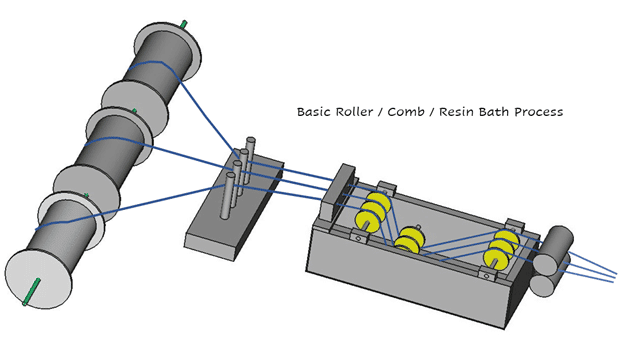Filament winding is a manufacturing process using continuous strands of tow from various materials such as carbon fiber Kevlar or fiberglass to yield hollow tubular parts. This process is used in vast number of applications for making tubular parts such as rocket bodies, pressure vessels such as compressed air tanks, suspension components in auto racing, and is even used for refueling aircraft midflight. The process’s ability to be highly adaptable to changing fiber orientations make it ideal for creating custom lightweight composite structures engineered to target the strength characteristics in many directions. The filament winding process is basically described as taking continuous filament tow, introducing that tow to resin and transferring the matrix onto a rotating mandrel and allowing it to cure as needed. As simple as it sounds, the engineering involved in streamlining these processes makes it highly customizable, ranging from using highly automated machinery to simple mechanical devices assembled in the shop. The imagination is often to the only limitation.
The fabrication process of filament winding starts with the raw material’s fibers. Kevlar, Fiberglass, Carbon Fiber or other filaments may be purchased on a roll as continuous “yarn” or “tow”. Generally, these tows would go into processing fabrics and unidirectional tapes, however, for filament winding, the tows are used exclusively from the roll to fabricate a product. A roll of tow is characteristically described by its tow size, just as it would be described in a fabric’s tow. Descriptions called out as “3k”, “6k”, or “12k”, characterize the number of fibers involved in creating the yarn or tow, which is basically the diameter of the group of filaments. This is important in the filament winding process as it helps determine important parameters in the part’s design and fabrication.

The rolls of tow are generally tensioned by mechanical means. This can variate depending on the design of the process. Many forms of tensioning involve springs to create friction from the roll free spinning, keeping the filaments tight to the tool it is conforming to. From prior experience it is best to keep the tensioning method as simple as possible, mitigating process variation. Tension can be applied at the rollers or by a separate device and is through combing, resin application, rolling, and tow placement upon the mandrel. The tension ensures process stability and repeatability and is commonly an important measure for quality because it is the process’s means of consistency and control while compacting the applied tow upon the mandrel.
The tow is then brought through a combing or separator device. This device helps bring uniformity to the raw filament before the tows are introduced to a resin bath. The separating device can be described as a comb, its importance being that it brings fiber uniformity in tension-control as the tow is dipped into the resin bath. As the tow comes through the bath it is then combed again to remove any excess resin from the tow.
The tow may then be flattened using “nip rollers” as needed to provide additional fiber uniformity before it is guided onto the “mandrel”.

The filament winding process is an innovative manufacturing solution that is widely customizable and repeatable, making it one of the most selected fabrication methods for composite cylindrical part applications.
